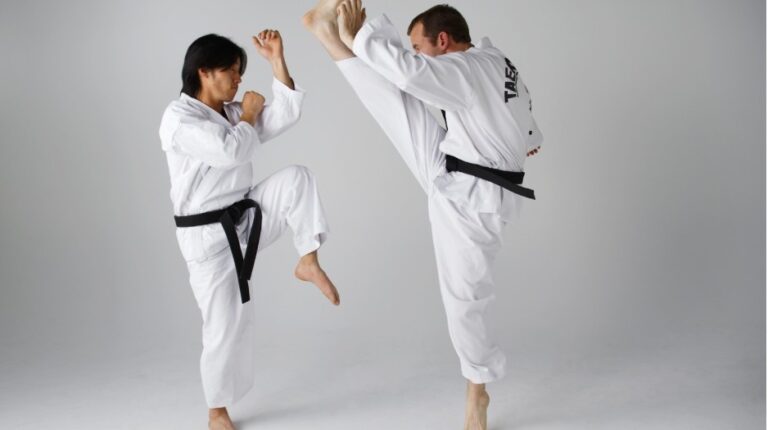Ah, the Taekwondo belt journey—a colorful roadmap from “I-just-learned-how-to-bow” to “Sensei-who-just-roundhouse-kicked-your-ego.”
Whether you’re a new student eyeing that first yellow belt or a martial arts curious cat on a Google deep dive, understanding the Taekwondo belt order is your first step to mastery (and bragging rights).
But don’t worry, we’re here to make this as fun as it is informative—with no need to break boards (yet).
What Is the Purpose of the Taekwondo Belt Order?
The taekwondo belt order isn’t just for show—it represents a student’s growth, both physically and mentally. Each belt color signifies a level of knowledge, discipline, and maturity. It’s like leveling up in a video game—only instead of extra lives, you earn respect, technique, and a mean sidekick.
The Standard Taekwondo Belt Order (Color by Color)
There may be slight variations between different Taekwondo schools and federations (WT, ITF, ATA), but in most U.S. schools, the taekwondo belt order generally follows this colorful path:
1. White Belt (Beginner)
Meaning: Innocence and a fresh start. You’re a blank slate.
Beginner mindset: “What’s a kiap and why are we yelling?”
2. Yellow Belt
Meaning: The seed has been planted. You’ve started learning the basics.
Techniques Introduced: Basic blocks, punches, and front kicks.
3. Orange Belt (sometimes used)
Meaning: The student begins to feel the warmth of knowledge.
Not all schools include this, but it helps bridge the gap between yellow and green.
4. Green Belt

Meaning: Growth and progress—your skills are sprouting.
You’ll start learning more complex kicks and combos. Things get spicy here.
5. Blue Belt
Meaning: Reaching higher, like the sky. Your foundation is strong.
Jump kicks, advanced sparring, and self-defense begin to intensify.
6. Purple/Brown Belt (varies by school)
Meaning: Maturity, hard work, and discipline.
You’re no longer a newbie. You know it, and more importantly—so does your instructor.
7. Red Belt

Meaning: Danger—you’re powerful, but not yet in control. Caution is key.
This belt is a warning (to both you and others). Mastery is near, but ego checks are required.
8. Black Stripe / Deputy Black Belt (optional)
Meaning: You’re at the gate, about to enter the realm of true martial artistry.
You’ll often assist in classes and demonstrate leadership.
9. Black Belt (1st Dan and beyond)

Meaning: The end of one journey and the beginning of another.
Contrary to pop culture, this isn’t “mastery”—it’s step one in a lifetime of learning. Black belt rankings (Dans) go up to 9th or 10th degree, often earned over decades.
Also Read: How to Tie Your Gi Belt
Is the Taekwondo Belt Order the Same Worldwide?
Mostly yes, but there are variations:
- WT (World Taekwondo) and ITF (International Taekwon-Do Federation) use slightly different forms, terminology, and sometimes belt colors.
- In the U.S., schools often include intermediate belts like orange, purple, or black stripe for kids and structured progress.
- ATA (American Taekwondo Association) has its own belt progression as well.
So when in doubt—ask your dojang!
Fun Facts About the Taekwondo Belt Order

- The belt colors represent elements of nature: white (snow), yellow (sun), green (plant), blue (sky), red (fire), black (universe).
- Taekwondo isn’t just kicks and splits—each belt level often includes forms (poomsae), board breaking, sparring, and theoretical knowledge.
- The time it takes to earn a black belt? Usually 3-5 years in the U.S., depending on age, effort, and school.
Why the Taekwondo Belt Order Matters
Still wondering why this rainbow of belts is such a big deal? Here’s why the taekwondo belt order is more than just cool-colored accessories:
- Structure: It gives students a clear path and short-term goals.
- Motivation: Belts are visual proof of progress.
- Respect: Higher belts are expected to mentor lower belts.
- Tradition: It connects millions of practitioners globally to the art’s deep cultural roots.
How to Progress Through the Taekwondo Belt Order Faster (Without Cutting Corners)
- Show Up Consistently – Attendance is non-negotiable.
- Practice Outside Class – 15 minutes daily goes a long way.
- Learn the Theory – Know your terminology, history, and philosophy.
- Ask Questions – Never be afraid to clarify or dig deeper.
- Set Micro Goals – Focus on mastering one form or kick at a time.
Also read: How to Tie a Taekwondo Belt
Climb the Belt Ladder, One Kick at a Time
Whether you’re a parent looking for the right martial arts school, a curious adult searching for discipline and fitness, or just fascinated by martial arts culture, understanding the taekwondo belt order is your roadmap to black belt bliss.
So the next time someone says, “Isn’t Taekwondo just kicking?”—you can smirk, adjust your belt, and explain how each color tells a story of discipline, growth, and sweat.
Because hey, behind every black belt is a white belt who didn’t quit.
Want to Find the Best Taekwondo Schools in the U.S. That Focus on Proper Belt Progression? Let me know your state or city—I’ll roundhouse kick you a list of top-rated dojangs near you!










